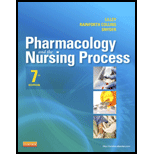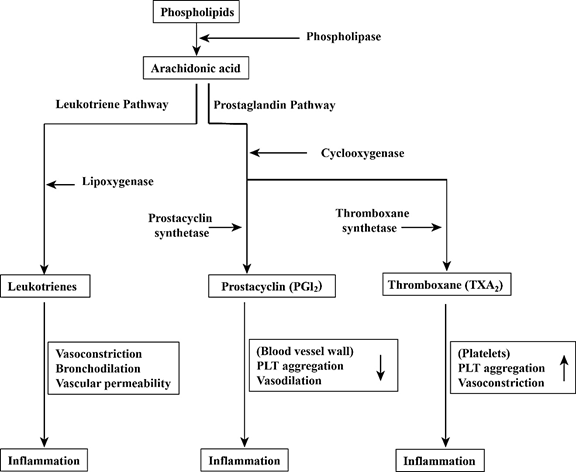
To discuss:
The inflammatory response and the part it plays in the generation of pain.
Concept Introduction:
Inflammation is the localized process initiated due to the injury or infection in the tissues. Tissue cells produce inflammatory cytokines such as (leukotrienes, bradykinin, histamine, and so on) that lead to the migration of macrophage immune cells to the injured tissue site and cause phagocytosis, which is an inflammatory-mediated response. Inflammation has a series of pathways involved. The common symptoms found in inflammation are pain and swelling.
Explanation of Solution
Pictorial representation:

Figure: Inflammatory pathways
The first and foremost step in the inflammation is triggering the inflammatory pathway mediated by the endogenous compounds present inside the host such as histamine, leukotrienes, prostaglandins, serotonin, and histamines. These endogenous compounds are collectively called as inflammatory compounds. There are two different modes of inflammatory pathways. One is leukotriene pathway and the other is prostaglandin pathway.
The common precursor phospholipid in the cell membrane is transformed to arachidonic acid mediated by phospholipase enzyme as a trigger during tissue injury. Phospholipase is an important inflammatory mediatory enzyme. Arachidonic acid enters the inflammatory pathway either by leukotriene or prostaglandin pathway.
Leukotriene pathway:
Leukotrienes are the eicosanoid mediated inflammatory agents. Arachidonic acid is
Prostaglandin pathway:
In this pathway, arachidonic acid is converted into prostaglandins like prostacyclin (PGl2), and thromboxane (TXA2), by the cyclooxygenase enzyme. These prostaglandins, in turn, mediate the production of proinflammatory cytokines such as histamines, and bradykinin, which induces the pain and edema. The occurrence of fever during inflammation is mediated by Prostaglandin E2 synthesized in the hypothalamus region. Prostaglandin-mediated inflammatory pathway brings vasoconstriction, vasodilation, and platelet aggregation in the host.
The inflammatory response is a body natural defense mechanism by which the tissue injury caused by endogenous substances such as pathogens, inflammatory agents are eliminated by the phagocytes. Macrophage cells migrate toward the inflammation site and execute the phagocytosis process. Vasoconstriction, vasodilation, and platelet aggregation during inflammatory pathways cause pain and edema at the inflammatory site.
Want to see more full solutions like this?
- CATH LAB FUNDAMENTALS I WORKSHEET #3 Patient #1 AO 113/68 M CaO2 mi/L LV 113/15 CvO2 ml/L RA M9 C.O. L/Min RV 33/8 S.V. PA 33/16 M C.I. ml/beat L/Min/M2 PAW M 17 S.I. ml/beat/M2 Hgb 15.1 S.V.R Dynes/sec/cm³ Hct % T.P.R Dynes/sec/cm³ PA Sat 69% P.V.R Dynes/sec/cm³ AO Sat 90% BSA M² HR 83BPM 02 Cons. _215_ml/min Ht _5_ft_5_in Wt. _213_ lbs Patient #2 AO 155/92 M CaO2 ml/L LV 155/21 CvO2 ml/L RA M 12 C.O. L/Min RV 41/22 S.V. ml/beat PA 41/20 M C.I. L/Min/M2 PAW M 20 S.I. Hgb S.V.R Hct 39 % T.P.R ml/beat/M2 Dynes/sec/cm³ Dynes/sec/cm³ 3 PA Sat 65 % P.V.R Dynes/sec/cm³ AO Sat _91 % BSA M² HR 88 BPM 02 Cons. 360 ml/min Ht 5 ft 11 in Wt. 169 lbs NAME:arrow_forwardCATH LAB FUNDAMENTALS I WORKSHEET #1 Patient #1 AO 151/89 M CaO2 mV/L LV 151/25 CvO2 mV/L RA M 17 C.O. L/Min RV 61/17 S.V. ml/beat PA 61/25 M C.I. L/Min/M2 PAW M 25 S.I. ml/beat/M2 Hgb S.V.R Dynes/sec/cm³ Hct 45% T.P.R Dynes/sec/cm³ PA Sat 68% P.V.R Dynes/sec/cm³ AO Sat 92% BSA M² HR 89 BPM 02 Cons. 245 ml/min Ht _5_ft_7_in Wt. _235 lbs Patient #2 AO 121/61 M CaO2 ml/L LV 151/19 CvO2 ml/L RA M 15 C.O. L/Min RV 51/15 S.V. ml/beat PA 51/20 M C.I. L/Min/M2 PAW M 19 S.I. ml/beat/M2 Hgb 15.2 S.V.R Dynes/sec/cm³ Hct % T.P.R Dynes/sec/cm³ PA Sat 76% P.V.R Dynes/sec/cm³ AO Sat 99% BSA M² HR 79 BPM Ht 02 Cons. 213 ml/min _5_ft_10 in Wt. _ 185 lbs 1arrow_forwardCATH LAB FUNDAMENTALS I WORKSHEET #1 Patient #1 AO 151/89 M CaO2 mV/L LV 151/25 CvO2 mV/L RA M 17 C.O. L/Min RV 61/17 S.V. ml/beat PA 61/25 M C.I. L/Min/M2 PAW M 25 S.I. ml/beat/M2 Hgb S.V.R Dynes/sec/cm³ Hct 45% T.P.R Dynes/sec/cm³ PA Sat 68% P.V.R Dynes/sec/cm³ AO Sat 92% BSA M² HR 89 BPM 02 Cons. 245 ml/min Ht _5_ft_7_in Wt. _235 lbs Patient #2 AO 121/61 M CaO2 ml/L LV 151/19 CvO2 ml/L RA M 15 C.O. L/Min RV 51/15 S.V. ml/beat PA 51/20 M C.I. L/Min/M2 PAW M 19 S.I. ml/beat/M2 Hgb 15.2 S.V.R Dynes/sec/cm³ Hct % T.P.R Dynes/sec/cm³ PA Sat 76% P.V.R Dynes/sec/cm³ AO Sat 99% BSA M² HR 79 BPM Ht 02 Cons. 213 ml/min _5_ft_10 in Wt. _ 185 lbs 1arrow_forward
- CATH LAB FUNDAMENTALS I WORKSHEET #6 Patient #1 AO 199/110 M CaO2 ml/L LV 199/24 CvO2 ml/L RA M 16 C.O. L/Min RV 41/16 S.V. ml/beat PA 41/25 M C.I. L/Min/M2 PAW M 24 S.I. ml/beat/M2 Hgb 15.1 S.V.R Dynes/sec/cm³ Hct % T.P.R Dynes/sec/cm³ PA Sat 71% P.V.R Dynes/sec/cm³ AO Sat 96% BSA M² HR 61 BPM 02 Cons. Ht 216 ml/min 4_ft_11_in Wt. _171_lbs Patient #2 AO 101/62 M CaO2 ml/L LV 101/12 CvO2 ml/L RA M 5 C.O. L/Min RV 20/5 S.V. ml/beat PA 20/10 M C.I. L/Min/M2 PAW M 12 S.I. ml/beat/M2 Hgb S.V.R Dynes/sec/cm³ Hct 43% T.P.R Dynes/sec/cm³ PA Sat 75% P.V.R Dynes/sec/cm³ AO Sat 97% BSA M² HR 68 BPM O2 Cons. 235 ml/min Ht _5_ft_5 in Wt. 145 lbsarrow_forwardCATH LAB FUNDAMENTALS I WORKSHEET #5 Patient #1 AO 112/63 M CaO2 ml/L LV 112/12 CvO2 ml/L RA M 8 C.O. L/Min RV 25/8 S.V. ml/beat PA 25/13 M C.I. L/Min/M2 PAW M 13 S.I. ml/beat/M2 Hgb 14.8 S.V.R Dynes/sec/cm³ Hct % T.P.R Dynes/sec/cm³ PA Sat 76% P.V.R Dynes/sec/cm³ AO Sat 96% BSA M² HR 82 BPM O2 Cons. 241 ml/min Ht _5_ft_9_in Wt. _180 lbs Patient #2 AO 140/82 M CaO2 ml/L LV 140/15 CvO2 ml/L RA M 12 C.O. L/Min RV 31/12 S.V. ml/beat PA 31/15 M C.I. L/Min/M2 PAW M 15 S.I. ml/beat/M2 Hgb 13.6 S.V.R Dynes/sec/cm³ Hct % T.P.R Dynes/sec/cm³ PA Sat 74% P.V.R Dynes/sec/cm³ AO Sat 93% BSA M² HR 71 BPM 02 Cons. 290 ml/min Ht _5_ft_0 in Wt. 188 lbsarrow_forwardCATH LAB FUNDAMENTALS I WORKSHEET #6 Patient #1 AO 199/110 M CaO2 ml/L LV 199/24 CvO2 ml/L RA M 16 C.O. L/Min RV 41/16 S.V. ml/beat PA 41/25 M C.I. L/Min/M2 PAW M 24 S.I. ml/beat/M2 Hgb 15.1 S.V.R Dynes/sec/cm³ Hct % T.P.R Dynes/sec/cm³ PA Sat 71% P.V.R Dynes/sec/cm³ AO Sat 96% BSA M² HR 61 BPM 02 Cons. Ht 216 ml/min 4_ft_11_in Wt. _171_lbs Patient #2 AO 101/62 M CaO2 ml/L LV 101/12 CvO2 ml/L RA M 5 C.O. L/Min RV 20/5 S.V. ml/beat PA 20/10 M C.I. L/Min/M2 PAW M 12 S.I. ml/beat/M2 Hgb S.V.R Dynes/sec/cm³ Hct 43% T.P.R Dynes/sec/cm³ PA Sat 75% P.V.R Dynes/sec/cm³ AO Sat 97% BSA M² HR 68 BPM O2 Cons. 235 ml/min Ht _5_ft_5 in Wt. 145 lbsarrow_forward
- CATH LAB FUNDAMENTALS I WORKSHEET #4 Patient #1 NAME: _ AO 145/100 M CaO2 _____ml/L LV 145/25 CvO2______ ml/L RA M 16 c.o. ______L/Min RV 41/16 S.V. _____ml/beat PA 41/25 M C.I. ______UMin/M2 PAW M25 S.I. _______ml/beat/M2 Hgb 13.1 S.V.R _______Dynes/sec/cm5 Hct % T.P.R________ Dynes/sec/cm5 PA Sat 65% P.V.R _______Dynes/sec/cm5 AO Sat 88% BSA __________M2 HR 120 BPM 02 Cons. 255 ml/min Ht-- 5- ft-7- in Wt. 198 lbsarrow_forwardCATH LAB FUNDAMENTALS I WORKSHEET #1 Patient #1 AO 151/89 M CaO2 mV/L LV 151/25 CvO2 mV/L RA M 17 C.O. L/Min RV 61/17 S.V. ml/beat PA 61/25 M C.I. L/Min/M2 PAW M 25 S.I. ml/beat/M2 Hgb S.V.R Dynes/sec/cm³ Hct 45% T.P.R Dynes/sec/cm³ PA Sat 68% P.V.R Dynes/sec/cm³ AO Sat 92% BSA M² HR 89 BPM 02 Cons. 245 ml/min Ht _5_ft_7_in Wt. _235 lbs Patient #2 AO 121/61 M CaO2 ml/L LV 151/19 CvO2 ml/L RA M 15 C.O. L/Min RV 51/15 S.V. ml/beat PA 51/20 M C.I. L/Min/M2 PAW M 19 S.I. ml/beat/M2 Hgb 15.2 S.V.R Dynes/sec/cm³ Hct % T.P.R Dynes/sec/cm³ PA Sat 76% P.V.R Dynes/sec/cm³ AO Sat 99% BSA M² HR 79 BPM Ht 02 Cons. 213 ml/min _5_ft_10 in Wt. _ 185 lbs 1arrow_forwardHow will knowing how to "Optimize Muscle Health in Aging" help a future dietitian in their practice? - Need a longer explanation that isn't bullet pointsarrow_forward
- How will knowing about "SGLT2 AND GLP1 Medications" help a future dietitian in their practice?arrow_forwardHow will knowing how to "Optimize Muscle Health in Aging" help a future dietitian in their practice?arrow_forwardHow will knowing how "New Mexico Double Up Food Bucks" help a future dietitian in their practice?arrow_forward
 Phlebotomy EssentialsNursingISBN:9781451194524Author:Ruth McCall, Cathee M. Tankersley MT(ASCP)Publisher:JONES+BARTLETT PUBLISHERS, INC.
Phlebotomy EssentialsNursingISBN:9781451194524Author:Ruth McCall, Cathee M. Tankersley MT(ASCP)Publisher:JONES+BARTLETT PUBLISHERS, INC. Gould's Pathophysiology for the Health Profession...NursingISBN:9780323414425Author:Robert J Hubert BSPublisher:Saunders
Gould's Pathophysiology for the Health Profession...NursingISBN:9780323414425Author:Robert J Hubert BSPublisher:Saunders Fundamentals Of NursingNursingISBN:9781496362179Author:Taylor, Carol (carol R.), LYNN, Pamela (pamela Barbara), Bartlett, Jennifer L.Publisher:Wolters Kluwer,
Fundamentals Of NursingNursingISBN:9781496362179Author:Taylor, Carol (carol R.), LYNN, Pamela (pamela Barbara), Bartlett, Jennifer L.Publisher:Wolters Kluwer, Fundamentals of Nursing, 9eNursingISBN:9780323327404Author:Patricia A. Potter RN MSN PhD FAAN, Anne Griffin Perry RN EdD FAAN, Patricia Stockert RN BSN MS PhD, Amy Hall RN BSN MS PhD CNEPublisher:Elsevier Science
Fundamentals of Nursing, 9eNursingISBN:9780323327404Author:Patricia A. Potter RN MSN PhD FAAN, Anne Griffin Perry RN EdD FAAN, Patricia Stockert RN BSN MS PhD, Amy Hall RN BSN MS PhD CNEPublisher:Elsevier Science Study Guide for Gould's Pathophysiology for the H...NursingISBN:9780323414142Author:Hubert BS, Robert J; VanMeter PhD, Karin C.Publisher:Saunders
Study Guide for Gould's Pathophysiology for the H...NursingISBN:9780323414142Author:Hubert BS, Robert J; VanMeter PhD, Karin C.Publisher:Saunders Issues and Ethics in the Helping Professions (Min...NursingISBN:9781337406291Author:Gerald Corey, Marianne Schneider Corey, Cindy CoreyPublisher:Cengage Learning
Issues and Ethics in the Helping Professions (Min...NursingISBN:9781337406291Author:Gerald Corey, Marianne Schneider Corey, Cindy CoreyPublisher:Cengage Learning





